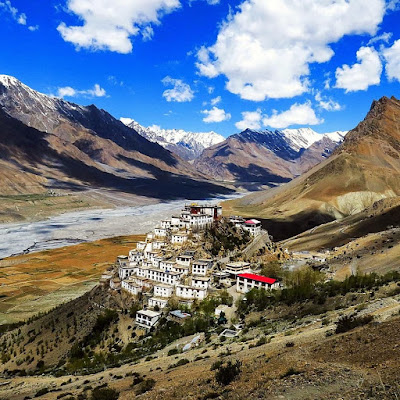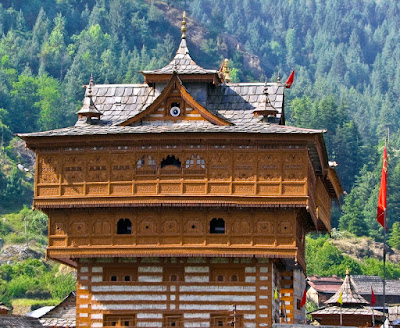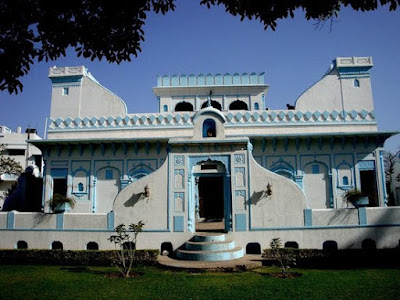Hidimba Devi Temple
This temple is also known as Dhungri Temple, situated in Manāli, one of the most
beautiful historical place in Himāchal Pradesh It is an ancient cave temple devoted
to Hidimba Devi, spouse of Bhima, a character of Indian epic Mahābhārata. The temple
is covered by a cedar forest called Dhungri Van Vihar at the foot of the Himālayas. The
beautiful historical place in Himāchal Pradesh It is an ancient cave temple devoted
to Hidimba Devi, spouse of Bhima, a character of Indian epic Mahābhārata. The temple
is covered by a cedar forest called Dhungri Van Vihar at the foot of the Himālayas. The
sanctuary is built over a big rock jutting out of the ground which was worshiped as an
image of the deity. The architecture was built in 1553.
The Hadimba devi temple was constructed in 1553 AD by Maharaja Bahadur Singh.The
temple is built around a cave where Devi Hadimba observed meditation. Hidimbi was
supposed to have lived there with her real brother Hidimb, and not enough is known
about their parents. Born into a Rakshasa family, Hidimba affirm to marry one who
would defeat her brother Hidimb, who was supposed to be very brave, strong and
fearless. During the Pandavas displacement, when they visited to Manali , Bhima
(one of the five Pandavas) killed Hidimb. Thereafter, Hidimba married Bhima and they
had a son, named Ghatotkacha.
People in Manali worship Hidimba devi as a idol. During Navratri all Hindus crosswise
the nation worship goddess Durga, but people in Manali worship their own goddess
Hidimba devi. No. of people can be seen outside the temple, but the crowd increases
too much during Navratri.The Indian epic Mahabharata described that the Pāndavas
stayed in Himachal during their exile. In Manali, the powerful person there, brother of
Hidimba, attacked them and in the ensuing attack Bhima,most strongest amongst the
Pandavas, killed him. Bhima and Hidimba, then got married and had a son named
Ghatotkacha, (who later proved to be a great fighter in the war against Kauravas). When
Bhima and his siblings returned from exile, Hidimbi did not followed him, but stood back
and did tapasyā (a combination of . penance ,meditation,and prayer ) so as to ultimately
attain the status of a goddess.
attain the status of a goddess.
KEY MONASTERY, SPITI
Key monastery is a Tibetan Buddhist monastery situated on top of a hill at an elevation
of 4,166 metres (13,668 ft) above sea level, and very close to the Spiti River, in the Spiti
Valley of Himachal Pradesh,district Lahaul and Spiti, India.It is the oldest and biggest
monastery of Spiti Valley and a religious training centre for Llamas. It reportedly had
100 monks in 1850. It is one of the best historical places.
Key monastery said to have been organized by Dromtön , a learner of the most famous
teacher, Atisha in the 11th century. This may however mention to a now destroyed
Kadampa monastery at the nearby town of Rangrik, which was apparently destroyed
in the 14th century when the Sakya sect rose to power with Mongol assistance.
Key monastery was assaulted again by the Mongols during the 17th century, during the
rule of the Fifth Dalai Lama, and became a Gelugpa organization. In 1830, it was
terminated again during the wars amidst Ladakh and Kullu. In 1841, it was badly damaged
by the Dogra army under Rahim Khan and Ghulam Khan. Later in that same year, it
experience more damage from a Sikh army. In the 1840s, it was destroy by fire and, in
1975, a extreme earthquake caused further damage which was repaired with the help of
the Archaeological Survey of India and the State Public Works Department.
The surrounding walls of the monastery are covered with murals and paintings, an model
of the 14th century monastic architecture, which developed as the result of Chinese force.
Key monastery has a collection of ancient books and murals , including Buddha pictures.
There are 3 floors, the first floor is underground and used for storing. One room, called the
Tangyur is sumptuously painted with murals. The ground floor has the amazing decorated
Assembly Hall and cells for many monks.
Key monastery now belongs to the Gelugpa sect, along with Dhankar monastery and
Tabo Monastery one of the 3 monasteries in Spiti."The monastery of Key, for occurrence,
shelter nearly 300 monks, who lives within the sacred walls in winter, and stays in the time
of summer with their parents or brothers employing in the fields or in carrying travellers
goods. These monasteries have their common heads, or rector, and the higher clerical
titles can only be obtained by the candidates proceeding in person to either Lhasa or
Shigatzee (Shigatse).A celebration of its prosperity was conducted in 2000 in the
presence of the Dalai Lama. A new worship Hall was inaugurated on 3 August 2000 by the
14th Dalai Lama. It was bestowed through a tableau in the 69th Republic Day celebration
held at Delhi.
 |
| Key Monastery, Spiti |
BHIMAKALI TEMPLE
Shri Bhima Kali Temple is a temple situated in Sarahan , Himachal Pradesh .This temple
is dedicated to the mother goddess Bhimakali, presiding divinity of the rulers of former
Bushahr State. The temple is placed about 180 km from Shimla, The capital city and is
one of the 51 Shakti Peethas. The town Sarahan is known as the gateway or entrance
of Kinnaur. Downward below at a distance of 7 km from Sarahan is the Satluj River.
Sarahan is identified with name Sonitpur mentioned in Puranas.
According to a legend, the indication of the goddess is reported to the Daksha-Yajna
incident when the ear of the Goddess Sati fell at this place and became a place of
worship as a Pithasthan.Currently in the form of a virgin the icon of this abiding goddess
is consecrated at the top storey of the new building. Below that floor the goddess as
Parvati, the daughter of Himalaya is hold as sacred as a divine consort of Lord Siva.
Lord Shri Raghunathji, Narsinghji and Patal Bhairva Ji , the guardian deity.
Lord Shri Raghunathji, Narsinghji and Patal Bhairva Ji , the guardian deity.
Sarahan was the capital of emperor of former Bushahr State. Bushahr dynasty earlier
used to mastery the state from Kamroo. Later the capital of state was shifted to
Sonitpur.Raja Ram Singh made Rampur as the capital. It is true that the country of
Kinnaur was the Kailash mentioned in Puranas, the place of Shiva. With its capital at
Sonitpur this former royal state was extended up to entire area of Kinnaur where for
sometimes Lord Shiva unrecognized himself as Kirata.Sonitpur is known as Sarahan
now. Banasur the enthusiastic devotee of Lord Siva, eldest among the one hundred
sons of great erode demon King Bali and the great grandson of Vishnu votary Prahlad,
during the Puranic age was the ruler of this royal state.
 |
| Bhimakali Temple, Sarahan. |
NALAGARH
Nalagarh is a municipal committee and beautiful city in Solan district in the Indian state
of Himachal Pradesh. It was the seat of the eponymous Rajput royal state, established
in medieval period as the state of Hindur.Currently Nalagarh is an emerging town for
industries as it hosts production units for leather, steel, chemicals, thread mills and
breweries ,thus air pollution is entirely a concern here. It is located a distance of 65 km
rom nearby main city Chandigarh. It has further been diminished to about 40 km after
the opening of new Chandigarh Siswan road.
Nalagarh is a gateway to beautiful state Himachal Pradesh . From Chandigarh it is 60 km
and from Delhi it is 300 km.It was established by the Chandela Rajputs in 1100 AD under
the name Hindur. The Fort of Nalagarh was built in 1421 during the reign of Raja Bikram
Chand on a small hill at the foothills of the mighty Himalayas, affording a bird's eye view
of the Shivalik hills beyond the Sirsa river, hence gave its name to the state, which further
enjoyed indirect rule all along the British Raj as a non-salute state.
In the early 20th century, Nalagarh State was one of the Simla hill states under Punjab
government. The country was invaded by the Gurkhas for some years before 1815, when
they were compelled out by the British, and the king was confirmed in ownership of the
territory. In the past main agricultural products were Grain and opium.
Nalagarh was administered by the Chandel Rajputs, who created from Chanderi in the
Bundelkhand region of central India. So many other Rajputs then inhabited this place
including Rathore, Parmar, Pawar, Panwar, Chauhan,Thakurs, Tomara,Bais. Many of
now stayed back as farmers in the Chikni Sirsa Valley. Nalagarh Fort encircled by endless
acres of greenery, with all modern amenities is an ideal retreat away from the frantic crowd
of metropolitan cities.Nalagarh is a Semi-Hilly Area, Where the summers are hot and
Winters are Dry and wet. Summers temperature does reach 45-46 degrees Celsius also
it could be Humid, Which Make "Feel Temperature" at 48-50 degrees Celsius. During rainy
season strong breezes are experienced.Nalagarh tangibly belongs to Himachal Pradesh
but Look and feel of it is mostly like Punjab. More than 85% people are Punjabi here. It is
a town Which is nearest to Pinjore in Haryana, and to Ropar in Punjab. The normal annua
CHAMUNDA DEVI TEMPLE
Chamunda also calls Chamundi, Chamundeshwari, Charchika and Rakta Kali is alarming
aspect of Devi, the Hindu holy Mother and one of the seven Matrikas the mother goddesses.
It is one of the best historical place in Himachal Pradesh, it has its own beautiful story pg
goddess Chamunda Devi. She is also one of the most important Yoginis, a group of eighty
one Tantric goddesses, who are aide of the warrior goddess Durga. The name is a combo
of Chanda and Munda, these two monsters were killed.She is closely colleague with Kali,
another violent aspect of Devi. She is labelled with goddesses Parvati, Chandi or Durga as
well.The goddess is often imitate as haunting cremation grounds or fig trees. The goddess
is worshipped by ceremony animal sacrifices along with offerings of wine and in the ancient
times, human sacrifices were present too. Originally a racial goddess, Chamunda was
absorb mentally in Hinduism and later entered the Jain pantheon too. Though in Jainism
the ceremony of her worship include only vegetarian offerings excluding meat and liquor
offerings.Ramakrishna Gopal Bhandarkar says that Chamunda was initially a tribal goddess,
honor by the tribals of the Vindhya Mountains in central India. These tribes were known to
offer goddesses animal as well as human sacrifices including ritual offerings of liquor. These
methods of worship were kept in Tantric worship of Chamunda, after absorption in Hinduism.
He proposes the violent nature of this goddess is due of her association with Vedic Rudra
identified with fire god Agni At times.It is best historical place to visit in Himachal.
The red or black coloured Chamunda is described as wearing a wreath of severed heads or
skulls (Mundamala). She is define as having 4,8,10 or 12 arms, holding a drum in hands, sword,
thunderbolt,trishula,a snake,skull-mace, a severed head and skull cup filled with blood
thunderbolt,trishula,a snake,skull-mace, a severed head and skull cup filled with blood
or panapatra (drinking vessel wine cup).Standing on a dead body of a man or seated on a
defeated demon or corpse. Chamunda is describe adorned by ornaments of skulls,bones
and serpents. She also use a Yajnopavita (a sacred thread worn by mostly Hindu priests)
of skulls. She wears a jata mukuta that is hat formed of piled,tangled hair tied with snakes
or skull ornaments. Sometimes a sickle-shaped moon is seen on her head.Her eye sockets
are defined as burning the world with flames. She is escort by evil spirits.She is also shown
to be covered by skeletons or ghosts and beasts like jackals, who are shown eating the beef
of the corpse which the goddess sits or stands on.
 |
| Chamunda devi temple. |
KAMRU FORT
Kamru is a beautiful village located in the Sangla Valley district Kinnaur, Himachal Pradesh
India. It is 2,700 m above the sea level. The village Kamru is an ancient capital of the
Bushahr principate. It is especially known for the tower-like fort at its highest point, which
was made by 5 Pandavas thousands of year ago during their reign.Inside the fort it is says
, there are about 36 crore (360,000,000) gods and goddess. There is also altar to Kamakhya
Devi inside the campus of fort which was brought there so many years ago from Assam. It
is about 2 km from the beautiful hilly town of Sangla it is situated on the foot of Kinner-
Kailash (House of Lord Shiva).According to a tradition, fort there is around 36 crore
(360,000,000) gods and goddess residing in the fort.
The Kamru Fort is located at an altitude of 2600 m above the sea level at 229 km from the
Capital city Shimla and 2 km from the tourist town Sangla Valley. It is located in the charming
location of the Sangla Valley and is entered through a series of gates. At the main entrance
gate of this fort is a huge image of Lord Buddha that welcomes you. There is also a beautiful
wooden balcony at the top of this fort along with an deity of Kamakhya Devi installed in its
third floor.It is one of the best historical places in Kinnaur, Himachal.
This deity of Kamakhya Devi is said to have been brought from Guwahati. There is also aBadrinath Temple situated within the campus of this Kamru Fort that dates back to the 15th
century. There is also famous fair held in the place to honour the main deity of the temple.
During this fair the deity of the temple is taken to Gangotri which is the origin of River Ganges.
 |
| Kamru Fort |

